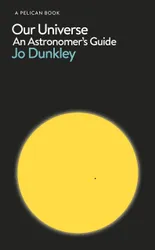This book presents a very readable overview of more or less everything we know about the universe we live in. It starts from the Earth, and what’s around us in our solar system, and works outwards from there. At each step the book covers the major discoveries, who made them, and how they were made. The author does a good job of giving due credit to women scientists, many of whom were unfairly exluded from the limelight when discoveries were made in the past. She also covers how the technology we use to observe the universe has evolved, how telescopes work, why we put telescopes in space etc.
The section on the Earth and our own solar system contains lots of facts about the sun and planets, and some good analogies and diagrams to help the reader understand the scale of objects and the distances between them. It also covers how we know how large the earth is, and how we’ve figured out how large and far away the other objects in our solar system are.
Working outwards from our Solar System, the book covers nearby stars, the Milky Way galaxy, other nearby galaxies, superclusters of galaxies, and the universe as a whole. Along the way we learn about the physics of stars, black holes and other objects, and the science behind the ways we can observe the universe, such as the different parts of the electromagnetic spectrum.
Our eyes can only detect visible light, which is a very limited section of the electromagnetic spectrum. There are other wavelengths we can’t see, and much of what we know about the universe has been gained by looking for light in non-visible wavelengths, such as with radio telescopes. I was fascinated to learn how infrared light was discovered by William Herschel, who split light up into a rainbow using a prism, then discovered that there was something invisible beyond red that caused his thermometer to heat up. The book suggests that phone cameras can actually detect infrared light, so that if you point a remote control at your phone camera, you can see where it lights up. I just tried it and it worked! I saw a little bright dot appear when I viewed the end of the remote on my phone camera and pressed a button on the remote.
Towards the end, the book covers dark matter and dark energy, so some of the subject matter overlaps with The 4% Universe and in fact that book is included in the references and further reading section.
One of the questions asked on the inside cover is “Is there life elsewhere?” Despite this, the book doesn’t talk about this much, other than mentioning that with so many potential planets out there in our own, as well as other, galaxies, many scientists think there must be other life somewhere. But there wasn’t any further discussion of this. Since this book is mostly about what we do know, I don’t think this is a big omission.
This book is a fantastic introduction to Astronomy. It doesn’t go into a huge amount of depth on any particular topic, but it gives a good general overview and lots of jumping off points. Everything is explained from basic principles that everyone can understand, and difficult concepts are explained extremely well. The book contains fantastic diagrams throughout to support the explanations in the text. It’s really enjoyable to read too.
